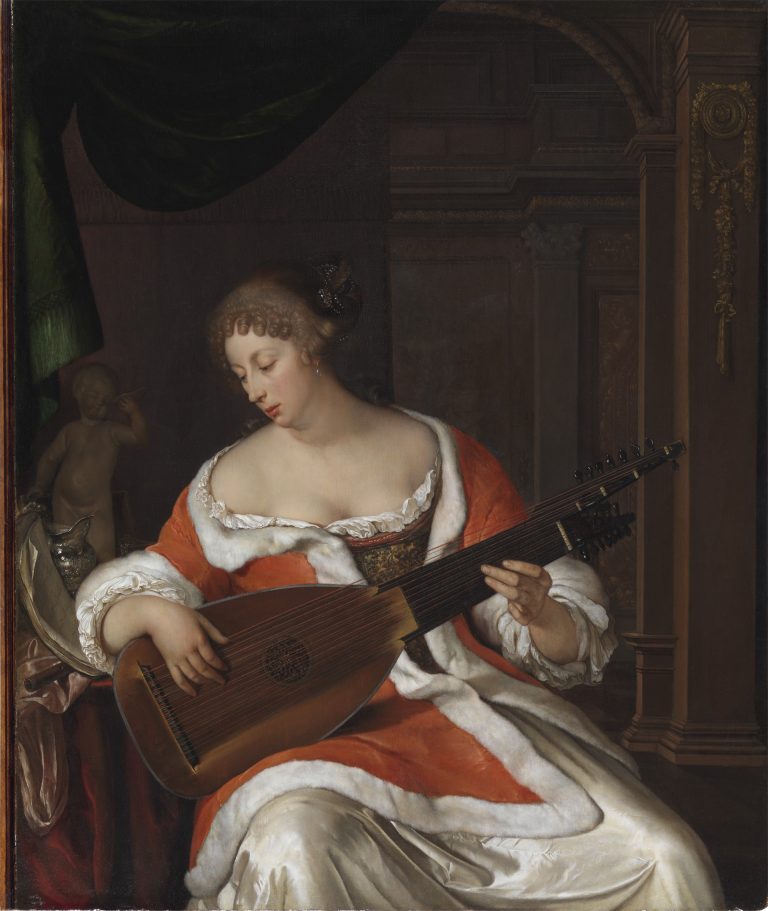Eglon van der Neer’s musician presents an elegant figure as she sits before stately architecture touched with gilt and partly masked by a swag of heavy curtain. She rests her elbow on a velvet-draped table crammed with costly objects, including a book of tablature, a flute, a rumpled satin cloth, a silver ewer, a marble (?) statue of a putto, and an open jewel casket. The woman herself is no less opulently packaged: she wears a fur-trimmed crimson house jacket over a shimmering white satin skirt and a bodice stiff with gold brocade. Emerging from the garments like Venus rising from the surf, the iridescent flesh of her plump arms and inviting décolletage is accentuated by the delicate frill of a white chemise. The young musician’s downcast gaze as she quietly listens to the sounds of her instrument help create the painting’s reflective mood and engaging character.
The woman plays what appears to be a two-headed “French” lute. An identical instrument appears in other of Van der Neer’s paintings of female musicians from the 1670s.1 Both as a solo instrument and in ensemble playing, the lute was highly regarded among elite players for its versatility and diverse repertoire; moreover, the warm tone produced by the gut strings was deemed ideal for vocal accompaniment. Although the lute’s basic structure remained the same, it was modified continually throughout the seventeenth century, at least partly in response to stylistic changes in the music itself.2 Much baroque music featured the basso continuo, in which the bass line provided the melody around which other instruments or voices improvised harmonies. Accordingly, the lower register of the lute was extended by modifying or adapting the instrument to accommodate additional (unstopped) bass strings. The archlute, chitarrone, theorbo, and two-headed “French” lute were among the more popular variants produced in this way. As the modifications were often quite individual, the differences between the instruments, and the terminology used to describe them, are rather vague: indeed, when considering the design of the theorbo, the seventeenth-century German composer and music theorist Michael Praetorius remarked, “Since constant changes take place in these various matters, nothing very definite may be stated about them here.”3 The two-headed lute is thought to have been invented by the French lutenist Jacques Gaultier (active 1617–52). An engraved portrait by Jan Lievens (1607–74) shows Gaultier holding an instrument similar to that depicted in Van der Neer’s painting (fig 1).4
Taking full advantage of his meticulous technique, Van der Neer has carefully calculated every aspect of the painting to entice the senses of touch, sight and sound, and in so doing, to emphasize the inherent sensuality of the image itself. The deliberate juxtaposition of so many luxurious surface textures prompts admiration of the artist’s skill, and the accuracy of the illusion allows the viewer to dwell on the pleasurable aesthetic and sensorial qualities of the actual objects.5 Nowhere is this more seductively presented than in Van der Neer’s rendering of the woman’s soft flesh: in visually “touching” her flesh (as well as the other objects in the painting), we are led to consider the touch of her fingers upon the strings of the lute. We imagine the sweet sounds produced by her playing, which prompts us to summon pleasant recollections of our own musical experiences. The reverse is also true, of course: seeing her fingers dance across the lute strings prompts us to imagine our own fingers testing surfaces and textures so meticulously and sensually presented.
In light of the unabashedly sensual pose of Van der Neer’s model—positioned frontally, her knees spread wide, her jacket opened, and her bodice artfully loosened—it is impossible not to connect with music’s more erotic associations. Musical motifs in paintings routinely connoted harmony in both its familial and amorous aspects, and Dutch paintings of love and courtship involved music more often than not. More specifically, a lute, or any of the instrument’s variant forms, could be a powerfully erotic symbol and often figured as a metaphor for a woman’s genitalia.6 Given the pervasive sensuality of the painting, it seems likely that Van der Neer had such erotic allusions in mind, albeit cloaked in an aura of elegance and refinement.
Like many of his colleagues, Van der Neer frequently refined the depiction of a particular theme in a series of closely related paintings executed over a short span of time. In the 1670s, for example, he produced several paintings of female lute players seated in sumptuous interiors: in addition to the present work, there are examples in a private collection in Hamburg; in the Staatliche Kunstsammlungen, Karlsruhe (dated 1677); in the Gemäldegalerie, Berlin; and in the Alte Pinakothek in Munich (fig 2).7 The last, dated 1678, repeats the present composition with just a few variations: the woman tunes the lute rather than playing it, and the music book has been placed at shoulder height rather than by her elbow. This latter modification enabled Van der Neer to give a more elegant turn to the musician’s head. The architectural background in the Munich painting, while still classical in style, has been modified to suggest a larger, lighter hall rather than a dark and intimate chamber. The woman’s costume and hairstyle have also been updated: the fur-trimmed house jacket ubiquitous in Dutch genre scenes of the 1650s, 1660s, and early 1670s has been discarded, revealing a sumptuous and vaguely historicizing mélange of silky garments more in keeping with fashions of the late 1670s. In both paintings, the emphasis on the classical architecture, the overt luxury of the costumes and accessories, and above all the cool perfection of Van der Neer’s technique reflect the taste for “French” elegance and refinement that spread throughout the Netherlands during the last quarter of the seventeenth century.
